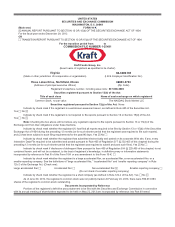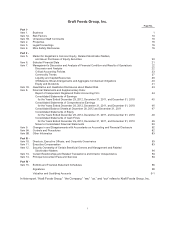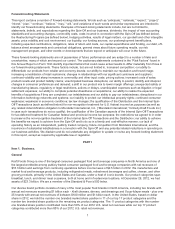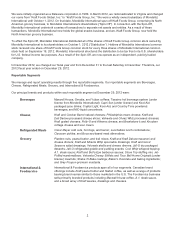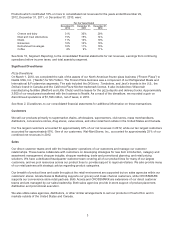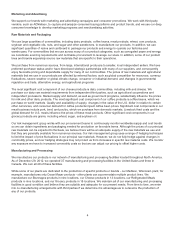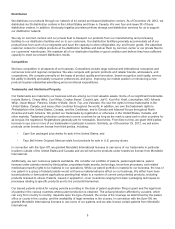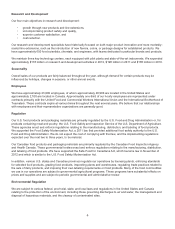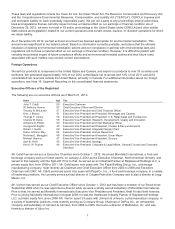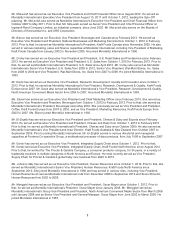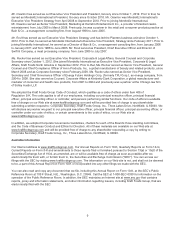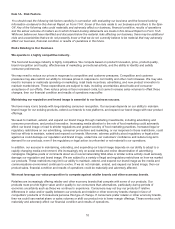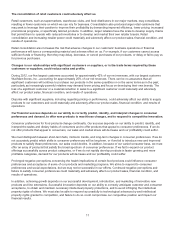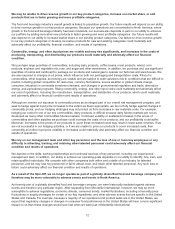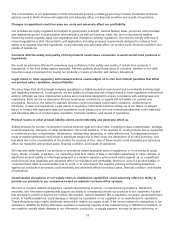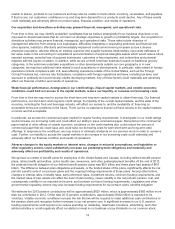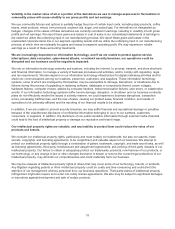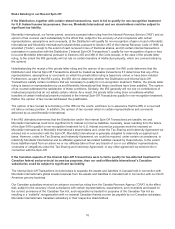Kraft 2012 Annual Report Download - page 8
Download and view the complete annual report
Please find page 8 of the 2012 Kraft annual report below. You can navigate through the pages in the report by either clicking on the pages listed below, or by using the keyword search tool below to find specific information within the annual report.Research and Development
Our four main objectives in research and development:
• growth through new products and line extensions,
• uncompromising product safety and quality,
• superior customer satisfaction, and
• cost reduction.
Our research and development specialists have historically focused on both major product innovation and more modestly-
scaled line extensions, such as the introduction of new flavors, colors, or package designs for established products. We
have approximately 650 food scientists, chemists, and engineers, with teams dedicated to particular brands and products.
We maintain three key technology centers, each equipped with pilot plants and state-of-the-art instruments. We expended
approximately $178 million on research and development activities in 2012, $198 million in 2011 and $185 million in 2010.
Seasonality
Overall sales of our products are fairly balanced throughout the year, although demand for certain products may be
influenced by holidays, changes in seasons, or other annual events.
Employees
We have approximately 23,000 employees, of whom approximately 20,900 are located in the United States and
approximately 2,100 are located in Canada. Approximately one-third of our hourly employees are represented under
contracts primarily with the United Food and Commercial Workers International Union and the International Brotherhood of
Teamsters. These contracts expire at various times throughout the next several years. We believe that our relationships
with employees and their representative organizations are generally good.
Regulation
Our U.S. food products and packaging materials are primarily regulated by the U.S. Food and Drug Administration or, for
products containing meat and poultry, the U.S. Food Safety and Inspection Service of the U.S. Department of Agriculture.
These agencies enact and enforce regulations relating to the manufacturing, distribution, and labeling of food products.
We supported the Food Safety Modernization Act, a 2011 law that provided additional food safety authority to the U.S.
Food and Drug Administration. We do not expect the cost of complying with that law, and the implementing regulations
expected over the next two to three years, to be material.
Our Canadian food products and packaging materials are primarily regulated by the Canadian Food Inspection Agency
and Health Canada. These governmental bodies enact and enforce regulations relating to the manufacturing, distribution,
and labeling of food products. We have supported the Safe Food for Canadians Act, which became law in November of
2012 and which is similar to the U.S. Food Safety Modernization Act.
In addition, various U.S. states and Canadian provinces regulate our operations by licensing plants, enforcing standards
for selected food products, grading food products, inspecting plants and warehouses, regulating trade practices related to
the sale of dairy products, and imposing their own labeling requirements on food products. Many of the food commodities
we use in our operations are subject to governmental agricultural programs. These programs have substantial effects on
prices and supplies and are subject to periodic governmental and administrative review.
Environmental Regulation
We are subject to various federal, provincial, state, and local laws and regulations in the United States and Canada
relating to the protection of the environment, including those governing discharges to air and water, the management and
disposal of hazardous materials, and the cleanup of contaminated sites.
6

